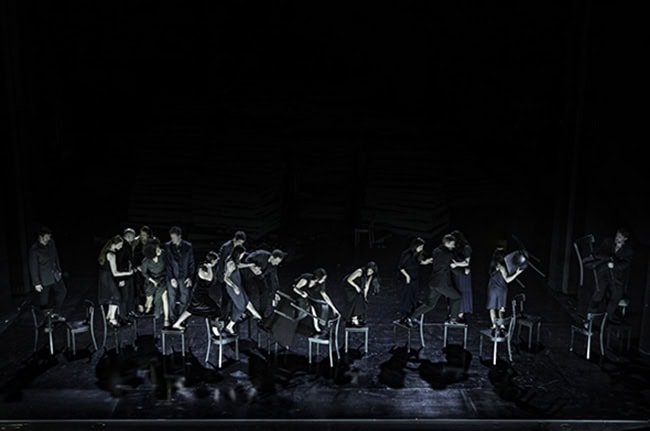Tanztheater Wuppertal Pina Bausch: Bluebeard at Sadler’s Wells
Posted: February 22nd, 2020 | Author: Nicholas Minns & Caterina Albano | Filed under: Performance | Tags: Beatrice Libonati, Béla Bartók, Bettina Wagner-Bergelt, Bluebeard, Jan Minarik, Oleg Stepanov, Ophelia Young, Pina Bausch, Rolf Borzik, Tanztheater Wuppertal Pina Bausch | Comments Off on Tanztheater Wuppertal Pina Bausch: Bluebeard at Sadler’s WellsTanztheater Wuppertal Pina Bausch, Bluebeard, Sadler’s Wells, February 14.

Because of the Béla Bartók estate’s withdrawal of the rights to the music, it has been a long time since Tanztheater Wuppertal Pina Bausch has been able to perform the 1977 creation, Bluebeard — While Listening to a Tape Recording of Béla Bartók’s Opera ‘Duke Bluebeard’s Castle’. But if you had never seen it before and, wanting to complete your review of Pina Bausch’s work, had spent an hour and fifty minutes watching it at Sadler’s Wells, you still would not have seen it. Bausch died in 2009 and, despite the company’s constant efforts to the contrary — now under the general and artistic direction of Bettina Wagner-Bergelt — it is ingenuous to expect anybody else to have the authority to restage her works, especially ones like Bluebeard that have been out of the repertoire for so long. Dancers whom Bausch rehearsed may remember the choreography and be able to transfer their individual insights and understanding to a younger generation — as in this reconstruction directed by two of the original cast, Jan Minarik and Beatrice Libonati — but Bausch’s precise, idiosyncratic process of moulding the individual dancers to her imagination and her imagination to the work can never be reproduced. It can be experienced, however, in film; there is an early, grainy VHS recording in which Minarik and Libonati embody Bausch’s conception of Bluebeard and Judith with such ferocious energy — as does the entire cast — it is far more immediate than the current reconstruction. Notwithstanding the physical signifiers, one major casualty of the Bluebeard at Sadler’s Wells is the sense of dark menace; gestures are repeated without the tics of feral obsession, while the sardonic humour of the men preening themselves at the front of the stage turns into gratuitous display. In addition to directing the reconstruction, Minarik and Libonati have to contend with the worldview of a young company in a very different era. Perhaps we have become so inured to psychosis and sexual violence that we find it amusing — as some in the audience expressed on Friday night — or perhaps the production simply lacks a sufficient sense of alienation to disturb our complacency.
Bausch’s creative life is so intimately integrated in her work that any presentation of her repertoire inevitably reflects on her legacy. For those who see this Bluebeard for the first time the legacy is affected, unintentionally on the part of the company and perhaps unknowingly on the part of the audience, by the absence of her approval. And yet while it may not be the real thing, seeing this example of Bausch’s early creative canon is enough to remind us of her genius for transforming the stage into choreographic drama and of those original dancers who embodied her vision so devotedly.
One might be tempted to ascribe a Jungian interpretation of the Bluebeard tale to Bausch’s interest in staging the work at that early point in her career. Having taken over the Wuppertal Opera in 1973 and choreographed two operas, as well as the Rite of Spring, and The Seven Deadly Sins, she had come to a creative door that threatened to close. The key to the forbidden room in the tale symbolizes consciousness; Judith can choose not to open the door or by unlocking it find the truth. For Bausch, working away from the theatre in Jan Minarik’s studio with a tape recorder and a small group of dancers who believed in her methods, the production of Bluebeard released her inspiration and launched the development of Tanztheater.
Based on an early recording of Bartók’s opera, Bausch’s rendering invokes classical ballet, expressionist dance, everyday gestures and dramatic theatre. Rolf Borzik’s set suggests the inside of the room Bausch had unlocked: clinically bare, with high white walls in a nineteenth century mansion or institution with inset windows and doors that mark the perimeter of the stage. The white floor is covered in armfuls of dry autumn leaves that record the passage of dancers passing over it. It is an imposing space and at the same time an intimate setting in which a tape recorder on a portable base takes on the role of fateful agent. Throughout the performance the character of Bluebeard (Oleg Stepanov) plays, stops, and rewinds the tape so as to provoke, arrest or replay his obsessive passion for his wife, Judith (Ophelia Young) that is magnified and enhanced by the entire cast. It is in the negotiation of such precise, repetitive details that the pervasive menace of the work is either contained or seeps away.
